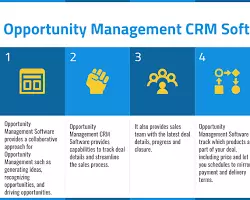Mastering Opportunity Management with CRM: Maximizing Sales Conversions in 2024

Opportunity Management in CRM Software
In the competitive sales landscape of 2024, effectively managing sales opportunities is crucial for maximizing revenue and achieving your sales goals. Opportunity management involves tracking, qualifying, and nurturing potential deals through the sales pipeline. Customer Relationship Management (CRM) systems provide the tools and insights needed to streamline opportunity management, improve win rates, and shorten sales cycles.
The Opportunity Management Process
Opportunity management encompasses the entire journey of a potential sale, from initial identification to closure. The key stages typically include:
- Lead Qualification: Evaluating leads based on their interest, fit, and potential to become paying customers.
- Opportunity Creation: Converting qualified leads into sales opportunities, assigning them a value and probability of closure.
- Opportunity Development: Nurturing opportunities through sales activities, such as meetings, calls, presentations, and proposals.
- Opportunity Tracking: Monitoring the progress of opportunities through the sales pipeline, identifying potential bottlenecks and adjusting strategies as needed.
- Opportunity Closing: Successfully converting opportunities into closed deals, ensuring timely follow-up and negotiation.
How CRM Transforms Opportunity Management
CRM software empowers sales teams with the tools and insights needed to optimize every stage of the opportunity management process. Key CRM features for opportunity management include:
- Opportunity Tracking: Visualize and track the progress of opportunities through the sales pipeline, providing a clear overview of your sales funnel.
- Lead Scoring: Assign scores to leads based on their potential value and fit with your ideal customer profile, helping prioritize high-potential opportunities.
- Sales Forecasting: Accurately predict revenue based on the value and probability of opportunities in your pipeline, enabling better resource allocation and decision-making.
- Activity Tracking: Log all sales activities, such as calls, emails, and meetings, to maintain a detailed history of each opportunity and identify areas for improvement.
- Deal Stage Management: Define clear stages for your sales pipeline and track the movement of opportunities through each stage, enabling better pipeline management.
- Competitive Analysis: Track competitor activity and win/loss ratios to gain insights into market trends and refine your sales strategies.
Best Practices for Opportunity Management with CRM
To maximize the effectiveness of your opportunity management, consider these best practices:
- Clearly Define Your Ideal Customer Profile (ICP): Focus on pursuing opportunities that align with your ideal customer profile to improve your chances of success.
- Use Lead Scoring: Implement a lead scoring system to prioritize high-potential opportunities and allocate resources efficiently.
- Personalize Communication: Tailor your communication to each prospect’s specific needs and interests, building rapport and trust.
- Track and Analyze Data: Monitor key metrics, such as win rates, average deal size, and sales cycle length, to identify areas for improvement and optimize your sales process.
- Collaborate and Communicate: Foster collaboration among sales team members, ensuring everyone is aligned and working towards shared goals.
Conclusion
Effective opportunity management is the key to converting potential into revenue. CRM software provides the tools and insights needed to streamline this process, enabling sales teams to prioritize high-potential deals, shorten sales cycles, and maximize win rates. By embracing CRM-powered opportunity management, businesses can achieve their sales goals and drive sustainable growth in 2024 and beyond.

Fundamentals of CRM with Dynamics 365 and Power Platform

Marketing Automation For Dummies

Successful Direct Marketing Methods: Interactive, Database, and Customer-based Marketing for Digital Age (BUSINESS BOOKS)

CRM & FFHH: analysis of real accidents

Connected CRM: Implementing a Data–Driven, Customer–Centric Business Strategy

Special Edition Using Microsoft CRM
Related Guides: See all
- AI-Powered CRM: Supercharging Customer Relationships with Intelligent Automation and Predictive Insights in 2024
- Omnichannel Engagement with CRM: Crafting Seamless Customer Journeys in 2024
- Personalization Powerhouse: How CRM Drives Customer-Centric Experiences in 2024
- Customer Segmentation Mastery with CRM: Unlock Personalized Marketing and Sales Strategies in 2024
- Mastering the Customer Journey with CRM: Elevate Experiences and Boost Loyalty in 2024
- Social CRM: Building Stronger Customer Relationships Through Social Media in 2024
- Cloud CRM: Revolutionizing Business Agility and Scalability in 2024
- Mobile CRM: Empowering Sales and Service Teams on the Go in 2024
- CRM Integration and API: Unifying Your Business Ecosystem for Seamless Operations in 2024
- Data-Driven Decisions with CRM: Harness the Power of Reporting and Dashboards in 2024